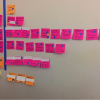 |
Using Sprints for Agile Coaching Discussing the work to be done as a group, building in short iterations, getting feedback, and looking for ways to improve are not just practices for development teams—it is an effective way to achieve any goal. Here, Ben Kopel details his experience of working with other agile coaches in a sprint to hire a new ScrumMaster.
|
|
 |
Using Agile to Lead Your Agile Transformation There's something ironic about starting an agile transformation by spending six months creating a detailed transformation plan. We have to move away from a prescriptive playbook and toward a more responsive transformation model. Why not use the agile transformation as your first opportunity to be agile?
|
|
 |
The Transparency Experiment: Improving Accuracy and Predictability in Scrum Using the iterative and incremental agile development framework Scrum should help manage product development, but some teams still have difficulty delivering features in a predictable manner. This organization decided to address the mismatch between what was being committed and what was accomplished by doing an experiment in work transparency.
|
|
 |
Reduce Uncertainty in Agile Projects with #NoEstimates Thinking Estimation uncertainty in software projects is often not driven by the difficulty of the problem we are trying to solve, but rather by the health of our codebase, the quality of process, and how much discipline we have in our management practices. If you want to improve your estimates, then agile and #NoEstimates thinking can have the biggest impact on your team’s success.
|
|
 |
For a Successful Agile Adoption, Put Education First Education is a vital ingredient in transformations, and it should be one of the first steps you take in moving to agile. Regardless of anyone’s level of agile experience, everyone should go through the same training because the real value of training isn't the lesson plan; it's the shared experience. Everyone across teams having the same foundation is essential.
|
|
 |
Delivering Value with Agile and #NoEstimates #NoEstimates is a challenge to the traditional thinking that estimation is essential to agile development. Ryan Ripley believes there are more interesting tools available to help us determine what value is and when we could realize it, while still staying aligned with the businesses and customers we serve. Learn some other ways to deliver value to your customers.
|
|
 |
Top 10 AgileConnection Articles of 2016 There is no question that agile has gone mainstream. If you aren't already using at least some agile methods, you soon will be. TechWell took a look at which topics the growing agile community cares most about and put together a list of the most popular AgileConnection stories and interviews of 2016. From failing Scrum teams and successful agile communication to facilitating feedback and simplifying user stories, we've curated the content you need to read as we head into a new year.
|
|
 |
Strategies for Implementing Agile in Small Organizations The experience of implementing agile in a company of thousands of employees differs widely from that of a company of hundreds. Although the risks can be greater, the rewards can be, too. If you work in a small company that is interested in transitioning to an agile workflow, consider these strategies for implementing agile in small organizations.
|
|
 |
The Reason Scrum So Often Fails Agile Teams The core of the Scrum framework for managing product development is the three key roles: ScrumMaster, product owner, and the development team. This triad is what makes Scrum so successful—when it works. However, it is the absence of these three roles that is the root cause of the majority of unsuccessful adoptions.
|
|
 |
The Values Essential to a Scrum Software Development Practice The Scrum Guide was updated recently to make values an explicit part of the framework: commitment, courage, focus, openness, and respect. When these values are embodied and lived by the team, the Scrum pillars of transparency, inspection, and adaptation come to life and build trust for everyone. Is your team practicing them?
|
|

